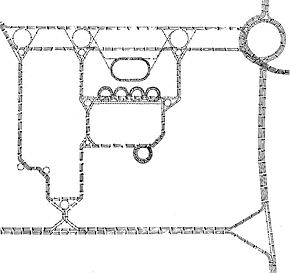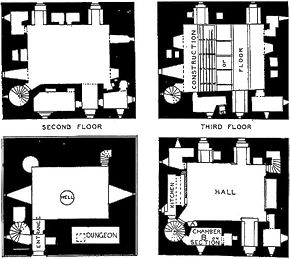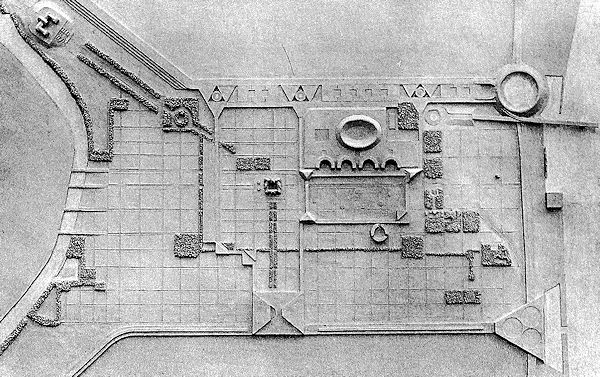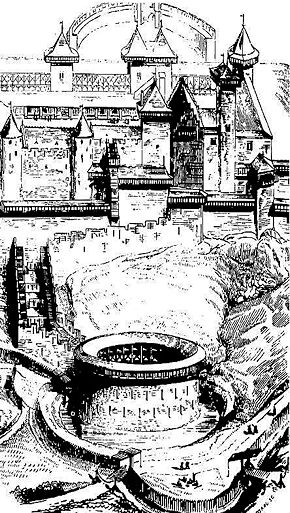
Market Street East. Traffic pattern.

Comlongan Castle, Dumphriesshire. Plan.
| |
At present, in this preliminary scheme, it is "Viaduct Architecture," the cars raised on long expressways which contain warehouses and so on beneath them and which lead to the Market Street center city area, now wholly enclosed as a built-up square by the viaducts and monumentalized by the great garages and shopping hemicycles. One of Kahn's old towers of 1957 abuts the Forum on the south side. The whole is beyond Rome, its scale large enough to subordinate, no less than to use, the motorcar. Water plays a part, flowing with the cars, since the northern viaduct is set with circular reservoirs, waiting to service fountains, as well as with triangular interchanges: again, fragments of Form, Piranesi's and Scottish, awaiting the chance to be Designed. But the grand Form conception is there, giving the heart of the city what Kahn believes it most needs: a defining wall.
It would seem that Furness' old "Chinese Wall," itself a raised viaduct lined with buildings, which Kahn had hoped to raze in 1941 and which later planners did in fact demolish, has reappeared. Now, however, it is four walls instead of one and so purposefully defines the central area rather than simply dividing the city in half. It is no longer primarily a barrier but a maker of urban space.
Kahn's wall, with all its associated hemicycles, circles, water, and towers, can also be found in one of Viollet-le-Duc's drawings of Carcassonne, the medieval town restored by him and especially admired by Kahn. In Perspecta, 4, Kahn had specifically recalled Carcassonne, describing one of his earlier Center City schemes:
Carcassonne was designed from an order of defense. A modern city will renew itself from its order concept of movement which is a defense against its destruction by the automobile.
Center City is a place to go to--not to go through.
Once more the question of past and present arises. Is Form, "dream-inspired," really Memory at the last? Is it in some way always pre-existent, a necessary stored pattern (fed by the experiences of the individual mind, not from a "collective unconscious") without which the transformations suggested by new particulars and fresh experiences have nothing to work upon, nowhere to begin, and so cannot create? It may be so for Kahn. It would appear to have been so for Wright and Le Corbusier, as what I have written about them elsewhere now seems to me to show. The memories of all three have eventually gone deep, and note should especially be taken of the fact that they are the strongest architects, not the weakest: the "Form-givers," as they have been called, not the Form-takers. One can envisage certain historical difficulties if the concept is carried far enough back in time, but such can undoubtedly be answered. It is probable that this is the way the mind creates, the way things come to be. One minor point seems clear: that to make anything in architecture, which has always been a large-hearted art, it is necessary to have loved something first.
| |

Market Street East. Model.

Carcassonne, drawing by Viollet-le-Duc, 1878.
|



